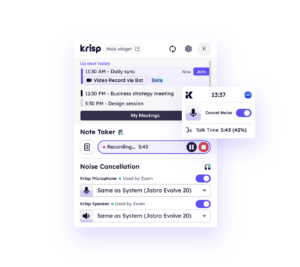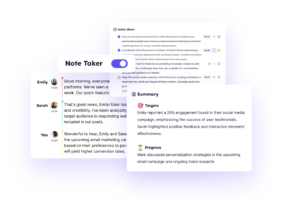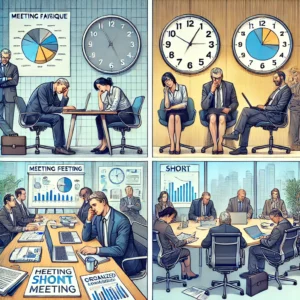Standing meetings are fundamental to keeping teams productive and in sync. In today’s fast-paced work environment, these regular check-ins ensure everyone is aligned, fostering better communication and collaboration. Thus, let’s dive into understanding such meetings, their benefits, and best practices for making them effective.
Standing Meeting Definition
A standing meeting is a recurring meeting scheduled at regular intervals, such as daily, weekly, or monthly.
Despite the standing meeting meaning, participants don’t have to stand. Instead, it refers to meetings that happen consistently, often with a similar agenda each time.

These meetings help maintain a steady rhythm within the organization.
Differences Between Standing and Stand-Up Meetings
While people often use the terms interchangeably, standup meeting and standing meeting meanings slightly differ.
Standup meetings are typically brief, daily check-ins where team members literally stand to keep the meeting short and focused. For instance, in a software development team, a daily standup meeting might involve each member quickly sharing what they accomplished yesterday, what they plan to do today, and any obstacles they face. This format encourages brevity and keeps the team aligned.
In contrast, standing meetings vary in length and format but are regular. These meetings might involve sitting, and their structure can be more flexible, accommodating different discussion topics.
For example, a marketing team might hold a standing meeting weekly to discuss ongoing campaigns, review performance metrics, and brainstorm new ideas. These meetings provide a consistent touchpoint for teams to stay coordinated on long-term projects.
Types of Standing Meetings
To understand standing meetings more vividly, let’s look at their types.
Weekly Team Meetings
Weekly team meetings are extended sessions held once a week to discuss ongoing projects, goals, and any issues that have come up. These meetings typically last 30 minutes to an hour and provide a more in-depth opportunity for team members to collaborate and strategize.
For example, in a sales team, a weekly meeting might cover the status of current leads, upcoming sales targets, and strategies to overcome challenges. Team members can share insights, discuss obstacles, and align their efforts towards common goals, maintaining momentum and ensuring everyone works cohesively.
Monthly or Quarterly Reviews
Monthly or quarterly review meetings are longer sessions focused on broader strategic goals, performance reviews, and future planning. These meetings can last several hours and provide a comprehensive look at the team’s progress over a more extended period.
For instance, a quarterly review in a product development team might involve assessing progress against project timelines, evaluating performance data, and planning the roadmap for the next quarter. These reviews help teams reflect on their achievements, identify areas for improvement, and set clear priorities for the future.
Other Types of Standing Meetings
Standing meetings can also include various other formats, depending on the organization’s needs.
| Meeting Type | Purpose |
|---|---|
| Progress Check Meetings | Keep stakeholders informed and aligned on ongoing projects (e.g., project status updates and client check-ins.) |
| One-on-One Meetings | Provide personalized feedback and coaching between managers and team members. |
| Action Review Meetings | Help teams learn from past projects and improve future performance (e.g., retrospectives, after-action reviews.) |
| Governance Meetings | Ensure high-level goals and compliance requirements are met (e.g., board meetings and quarterly strategic reviews.) |
Each meeting type serves a distinct purpose and contributes to organizational communication and decision-making effectiveness.
Benefits of Standing Meetings
Standing meetings offer several advantages:
- Improved Team Synchronization: Regular updates ensure everyone knows their responsibilities and the progress of various projects.
- Quick Problem-Solving: Immediate discussions help in resolving issues quickly.
- Consistent Communication: Keeps all team members informed and engaged, reducing miscommunication.
- Enhanced Accountability: Regular check-ins create a sense of responsibility among team members to meet their commitments.
- Increased Efficiency: When done right, standing meetings can save time by addressing issues promptly and keeping everyone aligned with the team’s goals.
To summarize, standup meetings are short, daily check-ins to maintain focus and alignment. In contrast, standing meetings are regular, more extended sessions with a flexible structure for discussing various topics.
Each type of meeting serves specific purposes, from quick updates to in-depth strategy discussions, enhancing team synchronization, problem-solving, and accountability.
How to Conduct an Effective Standing Meeting
Effectively conducting a standing meeting requires careful planning and execution. Here are some best practices:
Set Clear Goals
Setting clear objectives is crucial for the success of standing meetings. Determine the purpose of each meeting and ensure the goals are relevant and aligned with the overall strategy.
Regularly review and adjust these goals as needed. Clear goals provide direction and help keep the meeting focused on what matters most.
Follow a Structured Agenda
A structured standup meeting agenda helps keep the meeting on track. Create an agenda template and stick to it. Here’s a sample agenda for a weekly standup:
| Agenda Item | Description |
|---|---|
| Review Last Week’s Progress | Discuss what was achieved and any roadblocks encountered. |
| Set Goals for the Upcoming Week | Define clear, actionable objectives. |
| Q&A Session | Open the floor for any questions or clarifications. |
| Feedback and Adjustments | Collect feedback on the meeting’s effectiveness and make necessary adjustments for future meetings (weekly and daily standup meetings.) |
Assign Roles And Responsibilities
Clearly defining each participant’s role ensures that everyone knows their responsibilities and can prepare accordingly.
To streamline the process, assign roles such as meeting facilitator, timekeeper, and note-taker. Rotating these roles can also keep the meetings dynamic and ensure everyone is engaged.
Encourage Participation
Engagement is critical to productive standing meetings. Encourage all participants to contribute by asking for their input on the standup meeting agenda items and fostering an environment where everyone feels comfortable sharing their thoughts. Active participation ensures that the meetings are collaborative and that all relevant issues are addressed.
The Role of Technology in Improving Standing Meetings
Incorporating the right technology can significantly boost the productivity and efficiency of standing meetings. Tools like video conferencing software, collaborative platforms, and meeting assistants streamline meeting management. Here are some ways technology can enhance your standing meetings:
Video Conferencing Tools
Platforms like Zoom, Microsoft Teams, and Google Meet enable seamless communication for remote teams. These tools ensure that all participants can join the meeting regardless of location, fostering inclusivity and real-time collaboration.
AI Meeting Assistants
AI tools like Krisp improve meeting quality by providing noise cancellation, real-time transcription, and smart note-taking features. These features help maintain focus, capture accurate meeting records, and turn discussions into actionable insights.
Collaborative Platforms
Tools like Trello, Asana, and Slack facilitate ongoing collaboration by allowing team members to share updates, assign tasks, and track real-time progress. This integration ensures that the momentum of the standing meetings continues even after the session ends.
Scheduling And Reminders
Automated scheduling tools like Calendly and Google Calendar help set up recurring meetings effortlessly. Reminder features ensure that all participants know about upcoming meetings, reducing no-shows and enhancing punctuality.
Feedback And Improvement Tools
Collecting feedback is crucial for continuous improvement. Tools like SurveyMonkey and Google Forms can gather anonymous participant feedback, helping organizers tweak the format and agenda for better effectiveness.
By applying these technologies, organizations can transform their standing meetings from routine check-ins into powerful, interactive sessions that drive real progress.
Krisp: Your Complete AI Meeting Assistant
Imagine a meeting where every word is heard, background noise is a thing of the past, and capturing every detail is effortless. With Krisp, this isn’t just a dream—it’s your new reality.

Here’s why Krisp is the essential AI Meeting Assistant you didn’t know you needed:
Silence the Chaos With Noise Cancellation
Say goodbye to the distractions of barking dogs, traffic noise, and clattering keyboards. Krisp’s advanced noise cancellation technology ensures that your standing meetings remain focused and professional, no matter where you are.
Clear communication is crucial in any meeting, especially in fast-paced standing meetings where quick updates are essential. Krisp’s voice clarity enhancement sharpens every word, ensuring everyone is understood.
Document Every Detail With Real-Time Transcription And Note-Taking
Taking notes during meetings can be cumbersome and prone to error.
Krisp’s real-time meeting transcription provides an accurate, immediate record of everything discussed. This feature ensures no missing essential points and makes it easy to reference previous meetings, enhancing accountability and follow-through.
Krisp AI Note Taker allow you to have automated meeting summaries and key points, assigned tasks, and organized notes.

This feature transforms meeting discussions into actionable insights, helping your team stay on track and focused on their goals.
Enjoy Seamless Integration: Fits Right Into Your Workflow
Krisp AI Note Taker integrates with Zoom, Microsoft Teams, and Google Meet platforms. This seamless compatibility means you can enhance your meetings without changing your workflow, making Krisp an invaluable tool for any team.
Why Krisp Matters
Krisp isn’t just about technology; it’s about improving how your team collaborates and communicates. By removing distractions, ensuring clarity, and providing comprehensive documentation, Krisp transforms your standing meetings into practical, focused sessions that drive actual results.
To explore more tools that enhance productivity and meeting outcomes, check out our guide on the best AI note-taking apps.
Common Challenges And How to Overcome Them
Standing meetings can sometimes face challenges such as meeting fatigue and lack of engagement. Here are some solutions:
Dealing With Meeting Fatigue
Meeting fatigue can happen when meetings are too frequent, prolonged, or poorly organized.

To combat this, keep meetings short and to the point. Avoid scheduling back-to-back meetings to allow for mental breaks. Ensuring that meetings are productive and necessary will also help reduce fatigue.
Ensuring Engagement And Participation
A lack of engagement can derail a standing meeting. To keep participants engaged, ensure the meeting is interactive and everyone has a role.
Use icebreakers or quick check-ins at the start to create a welcoming atmosphere. Regularly request feedback on improving the meeting format and content.
Collecting And Using Feedback Effectively
Regular feedback is essential for improving standing meetings. Collect feedback verbally or through anonymous surveys at the end of each meeting.
Use this feedback to make necessary adjustments to the meeting format, stand up meeting agenda, and goals. This continuous improvement loop helps in maintaining the effectiveness of the meetings.
Wrapping Up
Standing meetings are a vital component of any productive team. By setting clear goals, following a structured agenda, and using technology like Krisp, you can ensure that these meetings are effective and engaging.
The benefits of standing meetings, such as improved synchronization, quick problem-solving, and consistent communication, make them indispensable in the modern workplace.
Frequently Asked Questions


